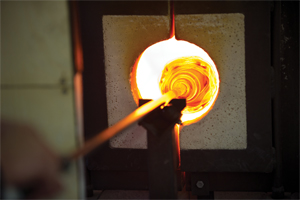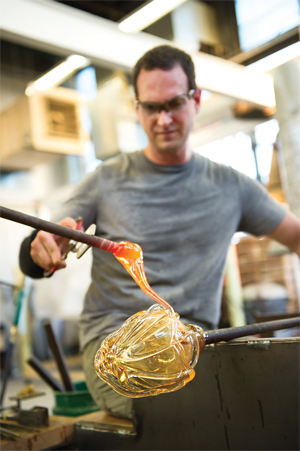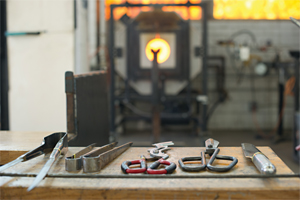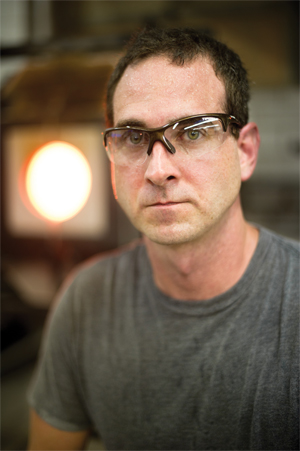In most labs across campus, audible “ooohs” and “awwwws” do not erupt as the work takes place, and certainly, observers do not break into spontaneous applause when the work is complete – unless you’re in Chad Fonfara’s glassblowing lab. There, the work—process and product—works its magic on the artists and onlookers, alike.
The lab, tucked away at the far west end of Otto Olsen, fills a space repurposed from a former woodworking classroom. Wood floors were removed to expose smooth, bare concrete. Now, three gas furnaces stand in a line against a block wall.
Nearby are two annealers, metal kilns used to bring the fragile, hand-blown glass pieces safely down to room temperature. The concrete block glory hole furnaces, steel rods, metal annealers and massive work tables that make up the “hot shop” are a sharp contrast to the row of colorful, delicate glass bowls lining an overhead shelf at one end of the room.
In Fonfara’s office, large, organic glass forms hang overhead, suspended from metal ligatures like so many giant cocoons. A wall of shelves at one end is lined with his glass works–a visual history of his artistry. Clearly, his current works are not the usual “vessels,” sparkling bowls and shimmering vases, he made in the beginning.
“My work has evolved from functional pieces to sculptural works in glass,” he said. And his work is earning him recognition.
Last spring, Fonfara was one of 12 featured artists in Esprit: A Taste of Art at the Museum of Nebraska Art (MONA). In addition, his work has been included in juried exhibitions at the Moss-Thorn Gallery in Hays, Kan., the Strecker-Nelson Gallery in Manhattan, Kan., and at MONA. He and his advanced glass students were commissioned to create more than 20 individual glassworks for the Spirit Biennial Fundraiser in 2008 and again in 2010. In 2011, he and two advanced students were commissioned to create 40 glass awards for the UNK Alumni Association’s Gold Torch Society.
 Further, his work has earned him acceptance into two of the most prestigious glass workshops in the nation. Last summer, he was selected to participate in workshops at Pilchuck Glass School near Stanwood, Wash., and at The Studio at the Corning Museum of Glass in Corning, N.Y. Pilchuck, an international center for education in glass arts, is well known, because Dale Chihuly, the internationally acclaimed glass artist, was one of the three founders.
Further, his work has earned him acceptance into two of the most prestigious glass workshops in the nation. Last summer, he was selected to participate in workshops at Pilchuck Glass School near Stanwood, Wash., and at The Studio at the Corning Museum of Glass in Corning, N.Y. Pilchuck, an international center for education in glass arts, is well known, because Dale Chihuly, the internationally acclaimed glass artist, was one of the three founders.
At The Studio workshop, Fonfara was one of only nine glassblowers in the nation accepted to participate in the Venetian techniques session, and one of only three to receive a partial scholarship to attend. The 2010 session at Corning was taught by Venetian glass maestro William Gudenrath. This summer, Fonfara was again accepted to attend a workshop at The Studio, this time with glass artist Boyd Sugiki.
“Because of the educational opportunity, I was able to add Venetian techniques to the current glass curriculum here at UNK,” he said. “It is my hope to similarly integrate glass sculptural techniques into the advanced glass curriculum while continuing to develop my body of work.
 “I think that is the beauty of teaching at the university level…growing the curriculum to reflect ongoing professional experiences and research. One feeds the other, and I enjoy passing down newly acquired knowledge to the students.”
“I think that is the beauty of teaching at the university level…growing the curriculum to reflect ongoing professional experiences and research. One feeds the other, and I enjoy passing down newly acquired knowledge to the students.”
Last fall, he brought Thom McMahon, a glass artist he met at Pilchuck, to the UNK campus as a visiting artist and guest lecturer. McMahon is from Smithville, Tenn.
“The week-long glass workshop benefitted UNK glass students by exposing them to a professional glass artist in a region of the country where there is a scarcity of working professional glass artists,” Fonfara said.
Every year, Fonfara opens the lab for public demonstrations, and this summer he made time for a demonstration for this article, although the “hot shop” is sometimes already at 97° F by 7 o’clock in the morning.
Unlike most art forms, glassblowing is a team endeavor, and Fonfara gives advanced glass students the opportunity to work as part of his team.
“Assistants are absolutely necessary, and this is where a lot of the learning takes place,” Fonfara said. “You need assistants to open furnace doors, and shield arms and hands using wood paddles to deflect the intense heat while the gaffer is working on the glass. At times, I need two or more knowledgeable assistants when I’m making larger pieces.”
As Fonfara works in the lab, it is clear why. Today, he and a student are making Venetian goblets. Students in his beginning glass classes can spend the first few semesters just learning how to make a good, thin cup. The avolios (hourglass shaped connecting pieces), stems and blown feet will be introduced in more advanced classes. Out of the first 100 attempts, perhaps five will be good enough to keep while learning to make a particular form. After another year of practice, the original forms will seem rudimentary compared to what the artist is then able to accomplish.
 The process begins when Fonfara (the gaffer) takes a hollow steel pipe, dips the pipe into the “melt” in the glass furnace and rolls the pipe in the melt to collect a “gather” of molten glass on the end.
The process begins when Fonfara (the gaffer) takes a hollow steel pipe, dips the pipe into the “melt” in the glass furnace and rolls the pipe in the melt to collect a “gather” of molten glass on the end.
Water boils at a mere 212° F. The furnace holding the “melt” is kept at 2,100° F. When the glass begins to cool, it will be plunged into the “glory hole furnace” to be reheated. The glory hole furnace heat is maintained at 2,000-2,300° F.
As the work continues, Fonfara rolls the gather on a thick metal table, a process called marvering. Putting his mouth against the other end of the pipe, he blows to create a bubble or “parison.” Next, he elongates the bubble of glass by swinging the pipe back-and-forth like a clock pendulum.
The work must move quickly. Glass cools rapidly and must be plunged back into the glory hole furnace repeatedly to keep it pliable.
As Fonfara works, at his command, the assistant moves in to help and then must move quickly out of the way, not only to avoid hampering the gaffer, but also for his own safety. It is like watching a carefully choreographed dance; there is a certain rhythm and graceful, flowing motion step-by-step throughout the process.
To work the glass, Fonfara sits at a bench that has arms on each side, laying the steel rod across the arms with the glass on his right. He begins rolling the steel rod with the palm of his left hand, while his right hand moves deftly from tool to tool, shaping the glass. His arms glisten with moisture as the well-developed muscles flex with every movement. Sweat runs down his cheeks and drips off his chin. Fonfara doesn’t notice. The work requires his complete concentration.
“It takes good coordination,” he said. “I liken the process to learning to play a musical instrument: each hand operating independently of the other, working together to create the piece. It takes a tremendous amount of time and practice to master this medium.”
Another command, and his assistant squats on Fonfara’s left, and when told, blows a short breath through the pipe.
“There are many aspects of the process that can be dangerous,” he said. “A wrong move with the pipe can knock someone’s teeth out. The gaffer must give clear and concise commands to the assistants throughout the process.” The gaffer is the lead and designer of the piece, controlling each step, telling the assistants what to do and when to do it.
With help from the student assistant, additional gathers are applied and shaped into the stem, handle and base. A gather is attached opposite the blowpipe to a solid iron rod called a punty. After the blowpipe is broken free, the gaffer can then shape and fire polish the open end. When the punty is detached, the rough spot that is left (punty mark) can be smoothed after annealing by grinding and polishing in the adjacent cold shop.
When the piece is complete, there is spontaneous applause from observers, and smiles of success from Fonfara and the student.
Getting to experience glassblowing as an observer or as a student is not a common experience on a university campus. Of the campuses in the University of Nebraska system, UNK is the only campus that offers classes in glassblowing. Further, according to Fonfara, there are only two other campuses in Nebraska that offer glassblowing, none in North Dakota or South Dakota, and only one in Kansas.
“Glassblowing classes (at UNK) are open enrollment,” Fonfara said, noting that, in the past, a class of 22 might have had only two art majors. “But I am refocusing the program. Glassblowing used to be mainly a fun cultural enrichment course for non-majors. Now with the new emphasis on mastering a greater variety of fundamental forms, higher standards for the signposts of good craftsmanship, the increased intensity of the curriculum and the new techniques being taught, I can prepare more students to graduate with the necessary skills to work in glass after graduation, whether as a glass assistant to a professional artist, at a glass school or museum, or in an MFA program.”
As an undergraduate student at UNK, Fonfara began his studies in the graphic design field before becoming a studio art major studying sculpture and ceramics. He then went to Kansas State University where he earned the M.F.A. in sculpture. The Omaha native took one glassblowing class as an undergraduate, but it wasn’t until he returned to the campus that he got hooked on glassblowing.
“My background is in traditional sculptural materials—bronze, wood and iron,” he said. “I began working in glass when
I started teaching in Kearney (UNK) in 2006.” This time the experience with glass was different.
“For the first two years, I studied foundational glassblowing techniques by making cups, bowls, cylinders, vases and goblets,” he said. “During my third and fourth year, my sculptural sensibilities and personal aesthetic took over as I began to distort the vessel form, challenging the proclivities of the glass and negating the functionality of the form. Gradually my work evolved into my current ‘Cases and Remains’ series.”
His most recent work, “The Glass Imaginarium,” was a featured Artist-in-Action installation this summer at the 35th Annual Smoky Hill River Festival held at the Oakdale Park in Salina, Kan. Fonfara was one of only a few featured installation artists chosen to exhibit. More than 70,000 people attend the three-day festival each year.
His installation featured six glass boats suspended in the river, so they appeared to be floating; 12 glass cattails, intermingled with the living cattails along the bank; and six metal tree forms, with three or four cocoon-like glass pieces suspended from each “tree.” The pieces were removed from the site at the end of each day and installed again each morning.
“Everything worked out perfectly,” he said of the installation. And although Kansas is known for high winds, Fonfara said, “The wind blew, but wasn’t a problem.” A group of children viewing the “Imaginarium” told him that the glass pieces looked like fairy eggs. One child exclaimed, “There
must be a lot of fairies around here!”
In the fall, he had a solo exhibition in the Skylight Gallery in the Museum of Nebraska Art (MONA). The works in that show were a continuation of his “Cases and Remains” series. Inspiration for one of the installations he created for the MONA show came from news coverage of thousands of red-winged blackbirds falling from the skies in Arkansas and Louisiana in January.
“When I saw the birds, I had an emotional reaction,” he said, and he began creating sculptural shapes of the red-winged blackbirds in glass. “No one in the glass world is impressed by being able to make one piece. Anyone can do something once. This is a medium where makers and collectors alike appreciate mastery. If you can repeat a form, that shows some skill.” He created more than 50 of the bird forms for a piece he titled “Blackbirds: Meditation on Death.”
His work has taken a new direction, from the functional to the more sculptural. The reason for the new direction is reflected in a piece he recently wrote: “It is the responsibility of any object-maker working in the medium of glass to create work that speaks to the greater human condition, conveys meaning and emotion, and addresses…themes relevant to our society rather than merely creating beautiful, but necessarily functional, commercial objects.”
When asked whether he considers himself an artist or a craftsman, he is quick to define himself: “I don’t like being called an artist. I am a ‘maker.’ I make objects. Glass is another medium to convey ideas visually.
“In sculpture, it is a mix of ideas and process,” he said. “In glass, you begin with the process first. Once you have the foundations in glass, then you push to bring concepts to it.”
Of the work, he said, “There are a lot of happy accidents, and a lot of disappointments.” Recently, he has been working with scale, making larger and larger pieces, but going larger
“I have to be careful. If I blow large pieces too thin, they collapse and fold in on themselves,” he said, holding one of his recent large, more visceral pieces. “Usually an experienced glassblower will be careful not to blow a piece this thin, but with these sculptural forms I am deliberately trying to get right up to the point where the form could fail due the thinness, so the pieces do not immediately look like a glass object but more like the papery thin forms in which they have their inspiration. There is so much that worked on this piece.
“Nobody is 100 percent happy with what they make. That is what leaves you hungry. When you fail, you replay it in your mind. When it works you repeat the process so the successful steps get ingrained through practice.
“There are hundreds of variables in making each piece. The process of working with glass is insatiable, because it takes so long master these variables. Everything happens in the moment and not every step goes as planned.
“It leaves you wanting more, to do it better, to gain a mastery, to expand one’s technical and visual vocabulary in glass in order to be able to create new forms and integrate new ideas in the medium of glass.”
